The REMenu is as close to an exact copy as you can get. I did notice though that it wasn't clipping the top of the menu when it slid down, it slid underneath the status / nav bar which to me didn't look right. Without having looked at the sliding logic (and with my impressive SE reputation of "8"), this is my quick take on how you make the menu appear.
- create a view for the contents of the menu (the table view etc)
- put it in an enclosing menu collapsed to a zero height, with the content sticking off the top of the collapsed menu view
- set the menu view to clip the contents so the top of the menu is not visible, then animate the contents down, as you animate the menu height larger.
This sample uses a simple gradient for the contents of the menu.
@interface BackgroundLayer : NSObject
+(CAGradientLayer*) redBlueGradient;
@end
@implementation BackgroundLayer
+ (CAGradientLayer*) redBlueGradient
{
CAGradientLayer *headerLayer = [CAGradientLayer layer];
headerLayer.colors =
@[(id) [UIColor redColor].CGColor, (id) [UIColor blueColor].CGColor];
headerLayer.locations = nil;
return headerLayer;
}
@end
@interface ViewController ()
@property (nonatomic, strong) UIButton* doIt;
@property (nonatomic, strong) UIView* menu;
@property (nonatomic, strong) UIView* nestedView;
@end
@implementation ViewController
- (void)viewDidLoad
{
[super viewDidLoad];
// create simple toggle button to test the menu
self.doIt = [UIButton buttonWithType:UIButtonTypeRoundedRect];
self.doIt.frame = CGRectMake(50, 50, 50, 44);
[self.doIt setTitle:@"Doit!" forState:UIControlStateNormal];
[self.doIt sizeToFit];
[self.doIt addTarget:self action:@selector(doIt:)
forControlEvents:UIControlEventTouchUpInside];
[self.view addSubview:self.doIt];
// menu
self.menu = [[UIView alloc] initWithFrame:CGRectMake(20, 200, 280, 0)];
self.menu.layer.borderColor = [UIColor blackColor].CGColor;
self.menu.layer.borderWidth = 3.0;
self.menu.clipsToBounds = YES;
// menu contents
self.nestedView = [[UIView alloc] initWithFrame:CGRectMake(0, -100, 280, 100)];
CAGradientLayer *background = [BackgroundLayer redBlueGradient];
background.frame = self.nestedView.bounds;
[self.nestedView.layer addSublayer:background];
[self.nestedView clipsToBounds];
[self.menu addSubview:self.nestedView];
[self.view addSubview:self.menu];
}
- (void)didReceiveMemoryWarning
{
[super didReceiveMemoryWarning];
// Dispose of any resources that can be recreated.
}
- (IBAction) doIt:(id) sender
{
if (!CGRectEqualToRect(self.nestedView.frame, CGRectMake(0, 0, 280, 100)))
{
[UIView animateWithDuration:0.15 animations:^{
self.menu.frame = CGRectMake(20, 200, 280, 100);
self.nestedView.frame = CGRectMake(0, 0, 280, 100);
}];
}
else
{
[UIView animateWithDuration:0.15 animations:^{
self.menu.frame = CGRectMake(20, 200, 280, 0);
self.nestedView.frame = CGRectMake(0, -100, 280, 100);
}];
}
}
@end
Cheers.
